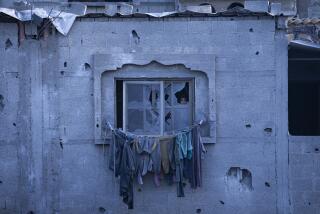Before Dawn, Frenetic Cairo Savors Its Calm
- Share via
CAIRO — I once had a little black cat named Sadie. She was a cat of the streets who entered my life through a doorway in Brooklyn and left it again five years later through another doorway, carelessly left ajar, in Cairo.
If fate, cars and other cats have been kind to her, Sadie will by now know the streets of Cairo better than I do. In searching for her, I too have discovered a city that few residents, foreign or Egyptian, ever see or bother to give much notice to if they do.
It is a city that exists only briefly each day, in the solitude of the very early morning, when most of Cairo’s 14 million people are either still asleep or groping for their alarm clocks.
In the stillness before dawn, before the cars that clog the potholed streets have awakened from their curbside slumber, before the sun that will pour down heat like lava has risen over the shabby skyline and before the noise, the filth and the congestion have begun to rub the nerves raw, it is still possible to savor one of the rare moments of peace and quiet that Cairo has to offer.
Since I am convinced that cats are just as smart as people--maybe smarter--I figured this would also be a good time to look for Sadie. I never found her. But, exploring my neighborhood between 4 a.m. and 6 a.m., I did find a city that is far different from the one that wakes up at 7 or 8.
This early-morning Cairo, a compendium of sights and sounds too delicate to survive long beyond dawn, is a city of singing birds, braying donkeys, peasants driving flocks of sheep through the streets, little boys with buckets swabbing the night’s dust from parked cars for the pennies these early chores will bring them.
Pacing the streets at this hour, it is possible, with a bit of imagination, to see Cairo as it must have been in the days when Muslim poets and scholars sang its praises and called it “Mother of the World.”
The old balustraded apartment buildings and statuesque villas, their decrepitude veiled in shadows, still look magnificent in semi-darkness. The gracious gardens hide their weeds and seem to be reliving memories of bygone tea parties. Down by the Nile, pinioned against the desert dawn, the Cairo skyline appears as the crenelated wall of some gigantic fortress battered by years of siege.
Strange Apparitions
In the dim half-light, the piles of rubble, mounds of rotting garbage and grit-caked hulks of abandoned cars common to Cairo streets assume strange, brooding shapes.
The veil slips away with the light of dawn, however, revealing the decayed and crumbling city that Cairo has become. Today, it would be hard to find anyone willing to sing of Cairo--unless the song were a dirge.
In daylight, the balustrades sag, the wrought-iron balconies are rusted and the garbage gives off foul odors as it bakes under the sun. There are whole parts of Cairo, especially in the older and poorer quarters, that look like a scene from the nuclear holocaust movie “The Day After.” All that is missing is Jason Robards staggering out of the rubble.
Cairo has come to this sorry pass in large part because high birthrates and large-scale migrations from the countryside have ballooned its population to proportions with which the city cannot possibly cope. Statistics are unreliable, understated, but even they speak of a fivefold increase in the population of Cairo over the last 30 years.
“There is only so much water that a cup can hold,” said Hassan Fathi, Egypt’s most famous architect. “And our cup began overflowing years ago.”
Shortsighted policies have not helped. Strict rent control, imposed in the 1950s by President Gamal Abdel Nasser and still in force, has frozen the cost of apartments in older buildings at a few dollars a month. It has also guaranteed neglect by landlords who will not spend money to maintain a building where the rent is barely enough, by today’s standards, to cover dinner for four.
The landlords bide their time, waiting for their buildings to collapse, as they do from time to time, so they can put up luxury housing or high-priced office buildings in their place.
The decay of old buildings and the slow pace of new construction have combined with the population crunch to create a housing shortage of such magnitude that nearly a million people live with the dead--in the tombs of Cairo’s sprawling cemeteries. The very poor make do without running water, electricity, garbage collection or sewers.
But even where such facilities as these exist, they are at best woefully inadequate. Not for nothing does the U.S. State Department recommend every inoculation in the book for travelers to Cairo.
Signs of Improvement
As bad as things appear, there are those who say they used to be worse and are starting to get better. In fact, the government of President Hosni Mubarak has placed a higher priority on solving public health and service problems than did previous administrations, and signs of improvement abound. American aid is building a new sewer system, and French experts are working on a subway that, it is hoped, will take some of the pressure off Cairo’s car-clogged streets.
Still, many Cairenes, resigned to what they see as insurmountable problems and irreversible decay, despair of their city ever becoming truly livable again.
“Cairo is like a pillow,” Saad Eddin Ibrahim, a respected political scientist, said when he was asked what he thought the aid could accomplish. “Like a pillow, no matter how hard you punch it, you can’t dent it.”
More to Read
Sign up for Essential California
The most important California stories and recommendations in your inbox every morning.
You may occasionally receive promotional content from the Los Angeles Times.













